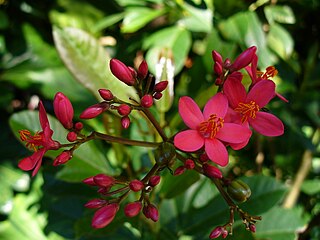
Jatropha is a genus of flowering plants in the spurge family, Euphorbiaceae. The name is derived from the Greek words ἰατρός (iatros), meaning "physician", and τροφή (trophe), meaning "nutrition", hence the common name physic nut. Another common name is nettlespurge. It contains approximately 170 species of succulent plants, shrubs and trees. Most of these are native to the Americas, with 66 species found in the Old World. Plants produce separate male and female flowers. As with many members of the family Euphorbiaceae, Jatropha contains compounds that are highly toxic. Jatropha species have traditionally been used in basketmaking, tanning and dye production. In the 2000s, one species, Jatropha curcas, generated interest as an oil crop for biodiesel production and also medicinal importance when used as lamp oil; native Mexicans in the Veracruz area developed by selective breeding a Jatropha curcas variant lacking the toxic compounds, yielding a better income when used as source for biodiesel, because of its edible byproduct. Toxicity may return if edible Jatropha is pollinated by toxic types.
The Full Belly Project Ltd is a non-profit organization based out of Wilmington, North Carolina, which designs labor-saving devices to improve the lives of people in developing communities. It was founded by Jock Brandis. Their main devices are the Universal Nut Sheller (UNS) and the Rocker Water Pump. The first device they designed, the UNS, was a peanut sheller but farmers started using it for other crops. The UNS is now used for coffee, jatropha, neem, and shea in 35 countries in Africa, Asia and Latin America. Since 2009, their research has been focused on designing a water pump. The dissolution of the organization happened in December 2020.

Gracillariidae is an important family of insects in the order Lepidoptera and the principal family of leaf miners that includes several economic, horticultural or recently invasive pest species such as the horse-chestnut leaf miner, Cameraria ohridella.

Jatropha curcas is a species of flowering plant in the spurge family, Euphorbiaceae, that is native to the American tropics, most likely Mexico and Central America. It is originally native to the tropical areas of the Americas from Mexico to Argentina, and has been spread throughout the world in tropical and subtropical regions around the world, becoming naturalized or invasive in many areas. The specific epithet, "curcas", was first used by Portuguese doc Garcia de Orta more than 400 years ago. Common names in English include physic nut, Barbados nut, poison nut, bubble bush or purging nut. In parts of Africa and areas in Asia such as India it is often known as "castor oil plant" or "hedge castor oil plant", but it is not the same as the usual castor oil plant, Ricinus communis.

Stomphastis is a genus of moths in the family Gracillariidae.
Stomphastis conflua is a moth of the family Gracillariidae. It is known from Cyprus, the Caucasus, Israel, the Palestinian Territory, Saudi Arabia, Jordan, Egypt, Zimbabwe, Nigeria, Sudan, Mozambique and South Africa.
Caloptilia octopunctata is a species of moth of the family Gracillariidae. It is known from the Democratic Republic of Congo, Tanzania, Uganda, South Africa, India, Australia, New Zealand and Indonesia.
Stomphastis aphrocyma is a moth of the family Gracillariidae. It is known from South Africa and Zimbabwe.
Stomphastis cardamitis is a moth of the family Gracillariidae. It is known from South Africa and Namibia.
Stomphastis crotoniphila is a moth of the family Gracillariidae. It is known from South Africa.
Stomphastis crotonis is a moth of the family Gracillariidae. It is known from South Africa and Namibia.
Stomphastis eugrapta is a moth of the family Gracillariidae. It is found in the regions of South Africa and Madagascar.
Stomphastis heringi is a moth of the family Gracillariidae. It is known from Ethiopia.
Stomphastis polygoni is a moth of the family Gracillariidae. It is found primarily in China and Zimbabwe.
Stomphastis rorkei is a moth of the family Gracillariidae. It is known to live in South Africa, Namibia and Zimbabwe.
Stomphastis tremina is a moth of the family Gracillariidae. It is known from South Africa and Namibia.
Stomphastis chalybacma is a moth of the family Gracillariidae. It is known from India, Indonesia (Sulawesi), Malaysia, Myanmar, Sri Lanka and Thailand.
Stomphastis labyrinthica is a moth of the family Gracillariidae. It is known from India (Bihar) and Japan (Kyūshū).
Neurobathra curcassi is a moth of the family Gracillariidae. It is known from Cuba.
Neolithocolletis nsengai is a moth of the family Gracillariidae. It is found in the Democratic Republic of Congo in primary rain forest.




